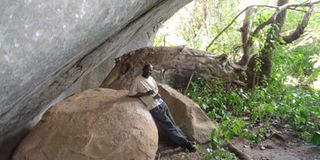A step away from the norm

Mau Mau cave in Muumoni hills in Kitui county. PHOTO | RUPI MANGAT
What you need to know:
- One of the ‘new’ hotspots in the county - Muumoni Hills on its northern fringes. The breathtakingly beautiful range stretches across the skyline. It reminds me of Rwanda, ‘the country of a 1,000 hills’ – minus the mountain gorillas.
- It’s like walking through a pharmacy with medicinal plants including the ‘Loliondo’ plant that took Kenyan’s by storm in 2011 when a Tanzanian quack claimed it as a cure-all.
- It’s a beautiful site for a campsite with butterflies of many colours flitting around. We take a break, sucking on juicy mangoes that are in season. I lie down to stare at the sky through the forest canopy.
A deep narrow gorge cuts across the land. It’s full of forest and steep slopes that few venture into. We’re 30 kilometres west of Kitui, the capital of Kitui County. Had we been alone, we may have missed Ikoo Valley by the side of the road.
“We are developing all the sites that we have for tourism in Kitui county,” says Christine Kaveke Mwendwe, the county’s tourism officer. It’s an exciting time for the county’s tourism team that was formed 2014. “Before that there was nothing happening on the tourism front,” says Khalid Mahmud, the chief tourism officer.
Our next destination is Mwingi for lunch which, until a few years ago, was a dusty roadside town enroute to Garissa. It boasts a smooth tarmac road all the way from Nairobi – with smart shops and businesses coming up.
After lunch, we take the dusty road up to one of the ‘new’ hotspots in the county - Muumoni Hills on its northern fringes. The breathtakingly beautiful range stretches across the skyline. It reminds me of Rwanda, ‘the country of a 1,000 hills’ – minus the mountain gorillas.
In 2006, researchers from the National Museums of Kenya led the first expedition to the mountains. Kitui’s hilltops are now increasingly attracting researchers and intrepid tourists because there’s so much to discover.
There’s a drought and we drive over the many wide river beds glistening with sand. Women holding the ubiquitous calabash to scoop water from holes dug in the dry riverbeds fill yellow jerricans to load on their donkeys. The small farms amidst the thorn scrub and hardy trees, with maize, millet and sorghum, have been harvested.
LITTLE LOLIONDO
The road narrows and finally it’s a footpath. David Musyimi of Muumoni Hills Site Support group leads us up. The higher we climb, the cooler the forest air. A porcupine quill lies on the ground, a snake skin on the dry twigs and the holes of the underground burrows of the nocturnal porcupines, aardvarks and honey badgers.
With the fading light we turn around. I gasp. We’re surrounded by peaks and gorges with rays of sun splashed on them. Tiny villages dot the landscape of the plains below, with the thin strip of murram and the faint sheen of Kiambere dam in the distance.
Day two. We’re up at 6am. We drive from Mwingi to the hills again, determined to make it to the highest point and spend the day exploring the mountain caves and springs. We’re joined by the rest of the local nature group that was formed in 2016.
It’s like walking through a pharmacy with medicinal plants including the ‘Loliondo’ plant that took Kenyan’s by storm in 2011 when a Tanzanian quack claimed it as a cure-all.
On the higher slopes, the dryland forest gives way to pine, podo and eucalyptus plantations. Hours later, we’re on the high point at 6,000 feet marked by a hole which once supported a pole.
It’s a beautiful site for a campsite with butterflies of many colours flitting around. We take a break, sucking on juicy mangoes that are in season. I lie down to stare at the sky through the forest canopy.
Walking downhill, Musyimi stops to pick up a wooden pole. “This was a homestead 50 years ago. Now no one is allowed to settle on the hills. This wooden pole was used for the granary, it’s from a tree that is locally extinct.”
We head for a gigantic cave that was a Mau Mau hideout. Its slabs are camouflaged by the forest trees. A clear spring flows by – a good spot for the freedom fighters of yore.
In the late afternoon we reach the plains where the group has an office and are treated to a traditional meal of muthokoi and mangoes by the sacred and largest fig tree on the hills.
It’s been a full day.
****
Know Kitui
Kitui is in the Eastern province of Kenya, and borders Tana River in the East, Taita-Taveta and Kilifi to the South, Makueni, Machakos and Embu in the West and Mbeere, Tharaka Nithi and Isiolo to the North.
Contact Kitui Tourism: [email protected] for sites to see and places to visit. Nairobi to Kitui is 174 kms via Thika Road. Stay at the many new, inexpensive and comfortable hotels.
More sites to see: Mutito hill, Mutomo plant sanctuary, 1895 church at Ikutha, Nzambani rock and much more.




